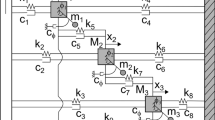Abstract
Spontaneous synchronization of an ensemble of metronomes placed on a freely rotating platform is studied experimentally and by computer simulations. A striking in-phase synchronization is observed when the metronomes’ beat frequencies are fixed above a critical limit. Increasing the number of metronomes placed on the disk leads to an observable decrease in the level of the emerging synchronization. A realistic model with experimentally determined parameters is considered in order to understand the observed results. The conditions favoring the emergence of synchronization are investigated. It is shown that the experimentally observed trends can be reproduced by assuming a finite spread in the metronomes’ natural frequencies. In the limit of large numbers of metronomes, we show that synchronization emerges only above a critical beat frequency value.
Similar content being viewed by others
References
S. Strogatz, Sync: The Emerging Science of Spontaneous Order (Hyperion, New York, 2003)
S. Strogatz, Physica D 226, 181 (2000)
A. Pikovsky, M. Rosenblum, J. Kurths, Synchronization: A Universal Concept in Nonlinear Science (Cambridge University Press, Cambridge, 2002)
C. Huygens, in Oeuvres Complètes de Christian Huygens, edited by M. Nijhoff (Societe Hollandaise des Sciences, The Hague, 1893), Vol. 5, p. 243 (a letter to his father, dated 26 Feb. 1665)
M. Bennet, M.F. Schatz, H. Rockwood, K. Wiesenfeld, Proc. Roy. Soc. London A 458, 563 (2002)
R. Dilao, Chaos 19, 023118 (2009)
M. Kumon, R. Washizaki, J. Sato, R.K.I. Mizumoto, Z. Iwai, in Proceedings of the 15th IFAC World Congress, Barcelona, 2002
A.L. Fradkov, B. Andrievsky, Int. J. Non-linear Mech. 42, 895 (2007)
K. Czolczynski, P. Perlikowski, A. Stefanski, T. Kapitaniak, Int. J. Bifur. Chaos 21, 2047 (2011)
K. Czolczynski, P. Perlikowski, A. Stefanski, T. Kapitaniak, Physica A 388, 5013 (2009)
J. Pantaleone, Am. J. Phys. 70, 992 (2002)
B. van der Pol, Philos. Mag. 3, 64 (1927)
Y. Kuramoto, I. Nishikawa, J. Stat. Phys. 49, 569 (1987)
H. Ulrichs, A. Mann, U. Parlitz, Chaos 19, 043120 (2009)
M. Kapitaniak, K. Czolczynski, P. Perlikowski, A. Stefanski, T. Kapitaniak, Phys. Rep. 517, 1 (2012)
Wikipedia, Metronom (2012 (accessed July 23, 2012)), https://en.wikipedia.org/wiki/Metronome
Wikipedia, Minicom (2012 (accessed January 14, 2012)), https://en.wikipedia.org/wiki/Minicom
Author information
Authors and Affiliations
Corresponding author
Rights and permissions
About this article
Cite this article
Boda, S., Néda, Z., Tyukodi, B. et al. The rhythm of coupled metronomes. Eur. Phys. J. B 86, 263 (2013). https://doi.org/10.1140/epjb/e2013-31065-9
Received:
Revised:
Published:
DOI: https://doi.org/10.1140/epjb/e2013-31065-9




